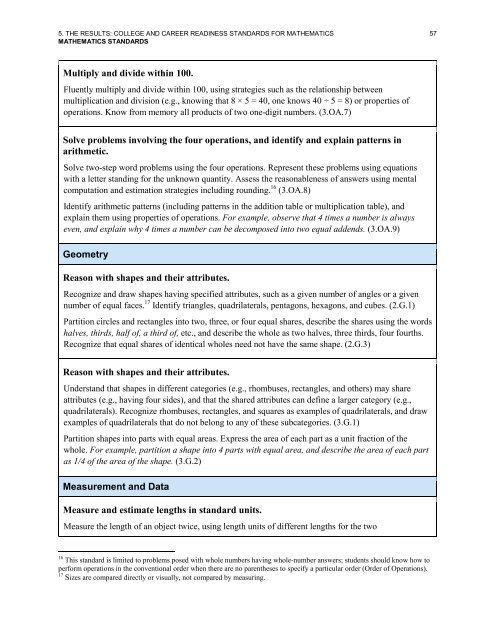CCRStandardsAdultEd
Create successful ePaper yourself
Turn your PDF publications into a flip-book with our unique Google optimized e-Paper software.
5. THE RESULTS: COLLEGE AND CAREER READINESS STANDARDS FOR MATHEMATICS 57<br />
MATHEMATICS STANDARDS<br />
Multiply and divide within 100.<br />
Fluently multiply and divide within 100, using strategies such as the relationship between<br />
multiplication and division (e.g., knowing that 8 × 5 = 40, one knows 40 ÷ 5 = 8) or properties of<br />
operations. Know from memory all products of two one-digit numbers. (3.OA.7)<br />
Solve problems involving the four operations, and identify and explain patterns in<br />
arithmetic.<br />
Solve two-step word problems using the four operations. Represent these problems using equations<br />
with a letter standing for the unknown quantity. Assess the reasonableness of answers using mental<br />
computation and estimation strategies including rounding. 16 (3.OA.8)<br />
Identify arithmetic patterns (including patterns in the addition table or multiplication table), and<br />
explain them using properties of operations. For example, observe that 4 times a number is always<br />
even, and explain why 4 times a number can be decomposed into two equal addends. (3.OA.9)<br />
Geometry<br />
Reason with shapes and their attributes.<br />
Recognize and draw shapes having specified attributes, such as a given number of angles or a given<br />
number of equal faces. 17 Identify triangles, quadrilaterals, pentagons, hexagons, and cubes. (2.G.1)<br />
Partition circles and rectangles into two, three, or four equal shares, describe the shares using the words<br />
halves, thirds, half of, a third of, etc., and describe the whole as two halves, three thirds, four fourths.<br />
Recognize that equal shares of identical wholes need not have the same shape. (2.G.3)<br />
Reason with shapes and their attributes.<br />
Understand that shapes in different categories (e.g., rhombuses, rectangles, and others) may share<br />
attributes (e.g., having four sides), and that the shared attributes can define a larger category (e.g.,<br />
quadrilaterals). Recognize rhombuses, rectangles, and squares as examples of quadrilaterals, and draw<br />
examples of quadrilaterals that do not belong to any of these subcategories. (3.G.1)<br />
Partition shapes into parts with equal areas. Express the area of each part as a unit fraction of the<br />
whole. For example, partition a shape into 4 parts with equal area, and describe the area of each part<br />
as 1/4 of the area of the shape. (3.G.2)<br />
Measurement and Data<br />
Measure and estimate lengths in standard units.<br />
Measure the length of an object twice, using length units of different lengths for the two<br />
16 This standard is limited to problems posed with whole numbers having whole-number answers; students should know how to<br />
perform operations in the conventional order when there are no parentheses to specify a particular order (Order of Operations).<br />
17 Sizes are compared directly or visually, not compared by measuring.


